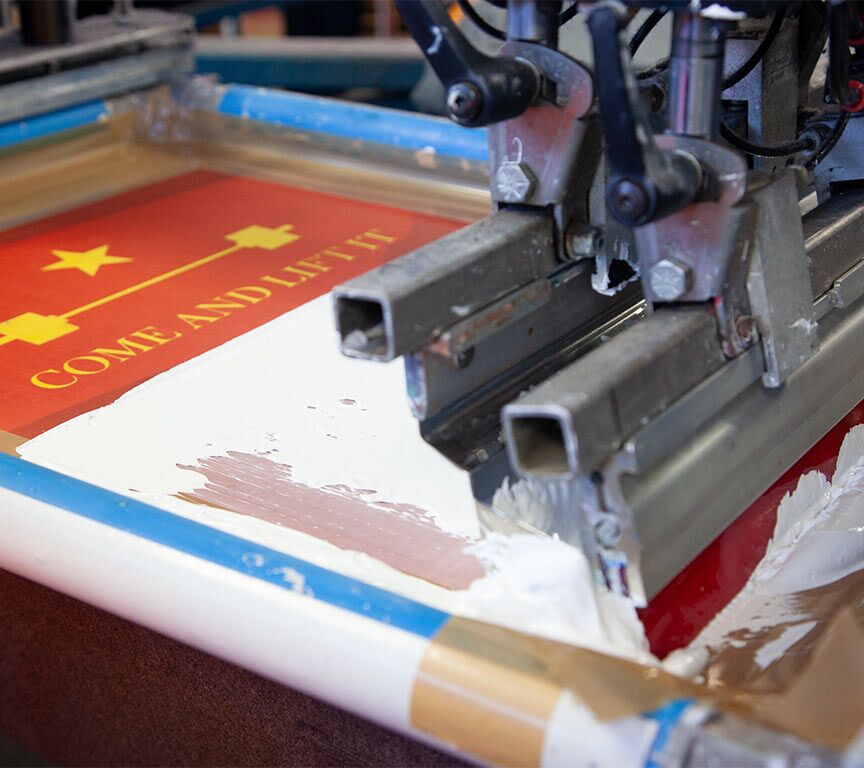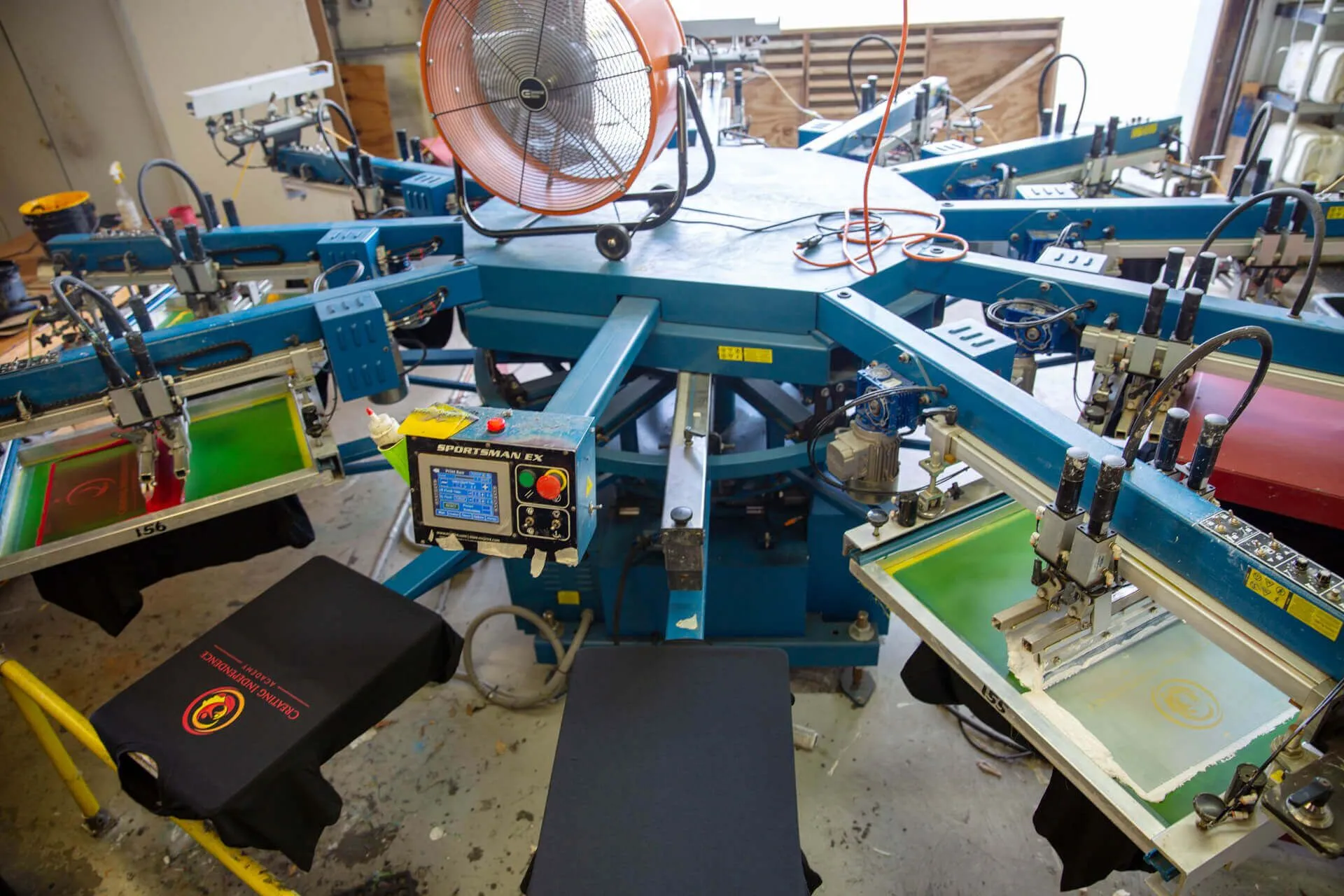Durable T-Shirt Printing for Everyday Wear
Durable T-Shirt Printing for Everyday Wear
Blog Article
Display Printing Uncovered: Everything You Need to Understand About T-Shirt and Garment Printing Techniques
If you've ever before wondered how those vibrant designs end up on your favored t-shirts, you remain in the ideal area. Screen printing is a fascinating method that integrates art with strategy, offering limitless opportunities for imagination. Recognizing the fundamentals, from equipment to ink selections, can significantly impact your results. Prepared to discover the essential elements that make display publishing an art form? Let's uncover the details that can raise your jobs.
The Fundamentals of Display Printing: Just How It Functions
When you plunge into display printing, you'll find it's both an art and a scientific research. At its core, display printing involves creating a pattern, or display, that enables ink to travel through just in particular locations (screen printing kit). You begin by selecting your design and preparing your screen with a light-sensitive emulsion. As soon as you expose this solution to light, it solidifies, leaving your style as an adverse area.
Placement the screen over the material, after that use a squeegee to press ink through the screen onto the garment. Each step is essential, and understanding them will elevate your screen printing skills, transforming straightforward garments right into unique, expressive pieces.
Sorts Of Screen Printing Strategies
Once you comprehend the essentials of display printing, it's time to explore the various strategies that can boost your designs. One popular method is conventional screen printing, where ink is pushed via a stenciled display. This strategy is terrific for strong, lively shades. There's water-based ink printing, which offers a softer feel and is eco-friendly, yet it requires a different approach to curing.
One more option is plastisol printing, recognized for its longevity and dazzling shades, making it a favorite for lots of brand names. Experiment with halftone printing to produce gradient results and detailed layouts.
Essential Tools for Screen Printing
To accomplish spectacular cause screen printing, having the appropriate equipment is basic. First, you'll require a sturdy display printing framework, which holds the mesh that transfers your design onto the garment. Next off, spend in high-quality mops; these are essential for applying ink equally across the display. You'll additionally call for a great exposure device to develop your displays, along with a washout booth for cleansing them after usage. A dependable heat source, like a conveyor clothes dryer or warmth press, is critical for healing your prints to guarantee longevity. Don't fail to remember a correct work area, outfitted with tables and storage space for your materials. Protective gear, such as masks and handwear covers, will certainly keep you safe from chemicals and inks. With the right tools, you'll be well on your method to generating professional-quality prints.
Choosing the Right Inks and Products
When choosing inks and products for display printing, you require to take right into account the sort of ink that works best for your task. Consider textile compatibility to assure your layouts look last and terrific long. Also, explore environmentally friendly ink options to make your printing process more lasting.
Kinds Of Display Inks
Selecting the right screen ink is essential for accomplishing vivid, long lasting prints that meet your job's demands. There are numerous types of display inks to take a look at. Specialized inks, such as glow-in-the-dark or metallic, can add one-of-a-kind effects to your styles.

Fabric Compatibility Considerations
Comprehending material compatibility is crucial for accomplishing high-grade screen prints, especially since various products react distinctively to different inks. When choosing inks, consider the fabric type-- cotton, polyester, or blends. For cotton, water-based inks function well, offering soft qualities and breathability. Polyester, on the various other hand, often calls for plastisol inks for far better bond and lively shades. If you're printing on blends, you could require to make use of a mix of both kinds. Constantly test your inks on example material to guarantee they stick properly and maintain shade stability. Additionally, bear in mind that fabric weight and structure can impact the final outcome, so picking the right ink and product combination is important for your project's success.
Eco-Friendly Ink Options
Green inks are ending up being a popular selection for screen printers who desire to minimize their ecological impact while preserving top quality. When selecting inks, consider water-based inks, which are much less hazardous and less complicated to tidy up contrasted to typical solvents. These inks bond well with materials, supplying dynamic outcomes without toxic chemicals. You may also check out eco-solvent inks that utilize less unpredictable organic substances (VOCs), making them a more secure option for both your health and wellness and the world.
Additionally, search for inks made from renewable energies, such as soy or vegetable-based options. By choosing the best inks and materials, you'll not only create spectacular designs yet likewise add to a much more sustainable printing process. Make the switch, and your prints will show your commitment to the environment!
Preparing Your Design for Screen Printing

Submit Style Needs
To guarantee your style looks sharp and vibrant on textile, you'll require to pay close focus to file format demands for screen printing. Make sure your design has a transparent history to stop undesirable white sides on your prints. Maintain shade settings in mind; CMYK is typical for display printing, so transform your RGB makes accordingly.
Color Separation Techniques
Color separation is a crucial step in preparing your design for display printing, and understanding it can greatly enhance your print high quality. You'll need to break your design right into individual colors, as each color calls for a different display during printing. Begin by determining all the colors in your design and develop layers each. You can make use of software program like Adobe Photoshop or Illustrator to separate and separate colors properly. Be certain to conserve each layer as a different file, usually in a format like TIFF or PSD. This accuracy not just guarantees exact shade representation yet likewise simplifies the printing procedure. By taking note of color splitting up, you'll accomplish vivid and specialist lead to your screen-printed garments.
Resolution and Size
Accomplishing the best cause display printing starts with ensuring your design has the ideal resolution and dimension. Ideally, your art work ought to go to least 300 DPI (dots per inch) for sharp, clear prints. If you utilize lower resolution, your last product may look pixelated and less than professional.
When it pertains to size, think about the measurements of your print location. Design your artwork to match the last print dimension, ideally developing it in the real measurements you'll be publishing. This way, you'll avoid any type of unanticipated scaling issues.
Always examine your layout in both vector and raster formats. Vector graphics can be scaled without losing top quality, making them perfect for screen printing. Preparing correctly will assure your layout looks outstanding on every garment!
Step-by-Step Display Printing Refine
Screen printing is a vibrant process that enables you to produce vibrant designs on numerous surface areas. To obtain started, you'll require a screen, emulsion, and your chosen ink.
After rinsing the unexposed solution, your screen prepares. Establish it up on your printing surface and straighten your garment below it. Put ink onto the screen and use a squeegee to press the ink through the pattern onto the textile. Raise the screen thoroughly and allow the print dry. Ultimately, treat the ink using warm to assure resilience. That's it! You've efficiently display published your style.
Tips for Successful Display Printing Projects
While you're diving right into your screen printing jobs, bear in mind that prep work is key to success. Beginning by collecting all your materials-- inks, garments, screens, and mops. A clean work space aids avoid undesirable mistakes, so clean before you begin.
Following, verify your art work is high-resolution and appropriately sized for your garment. Test your display for appropriate exposure and tidy it extensively to stay clear of spots. When mixing your inks, follow the producer's guidelines to attain the right uniformity.
Throughout printing, apply also stress with your squeegee for constant results. Don't hurry; take your time to verify each print fulfills your criteria. After printing, allow your garments dry totally prior to managing or packaging them.
Finally, constantly look these up maintain a sample of your work for future recommendation. In this manner, you can assess your development and improve your strategies in time. Happy printing!

Often Asked Concerns
Exactly how Long Does It Take to Establish a Display Printing Task?
Establishing a display printing task normally takes around thirty minutes to an hour. You'll prepare the displays, mix inks, and adjust journalism. The moment differs based on complexity and experience, so stay arranged!
Can I Publish on Various Textile Keys In Making Use Of the Same Method?
Yes, you can print on different fabric types using the exact same strategy, but you'll need to adjust your inks and settings. Some textiles take in ink in different ways, so trying out warranties the most effective outcomes for every product.
What Prevail Blunders to Avoid in Screen Printing?
When screen printing, stay clear of usual blunders like utilizing the incorrect ink, ignoring proper direct exposure times, or avoiding pre-press checks. Constantly examine your arrangement and preserve clean displays to ensure quality results each time.
Exactly How Can I Properly Clean and Maintain My Screen Printing Devices?
To effectively tidy and preserve your display printing devices, you ought to frequently go to this website clean screens with suitable solvents, examine squeegees for wear, and assure all devices are stored dry and dust-free. Uniformity stops costly fixings and improves performance.
Is Screen Printing Ecologically Pleasant Compared to Various Other Approaches?
Screen printing can be much more eco-friendly than various other approaches, particularly if you utilize water-based inks and eco-conscious products. By picking lasting materials and practices, you decrease waste and lessen your impact on the earth.
Display Printing Uncovered: Every Little Thing You Need to Know About Tee Shirt and Garment Printing Strategies
At its core, display printing entails developing a pattern, or display, that allows ink to pass via only in particular areas. Placement the screen over the textile, after that utilize a squeegee to push ink via the screen onto the garment. One prominent approach is traditional screen printing, where ink is pushed with a stenciled screen.When choosing inks and materials for display printing, you need to take into account the type of ink that functions best for your project.
Report this page